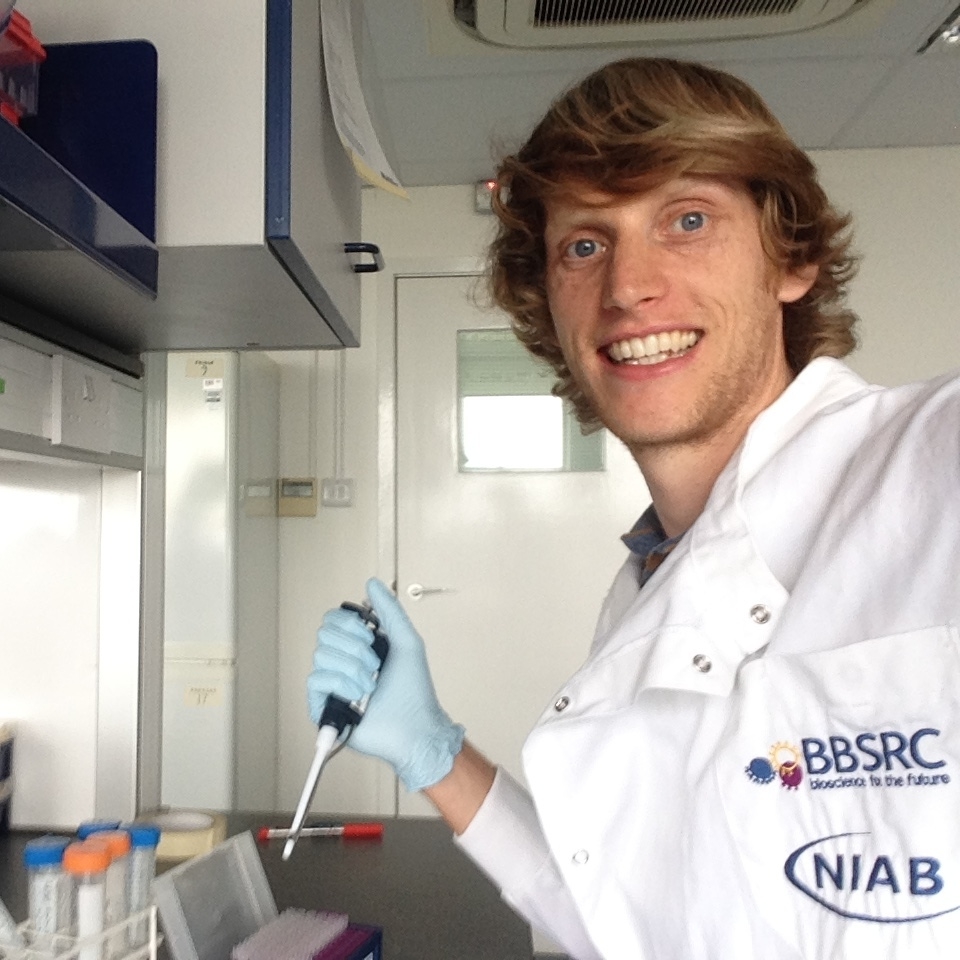Harvesting the genetic value of interspecific wheat introgressions
The aim of this project is to flow sort, sequence and analyse wheat chromosome 4A for a NIL pair extracted from the NIAB MAGIC population and differing by presence of a Robigus-derived introgression, to establish the most likely candidates responsible for phenotypic effects observed to be caused by the introgressions.
The Idea
Incorporating genes from wild relatives has played a major role in the breeding of modern wheat varieties. In particular, many important disease resistance and yield enhancing genes have been successfully transferred from wild grass species into the cultivated wheat gene pool. Historically this process has been rather haphazard, achieved via the process of wide crossing and phenotypic selection in breeding populations. As a result, deleterious traits, such as disease susceptibilities are often also brought in together with the positive genes. The advantages (and disadvantages) of unintended transfers often only become apparent late in the breeding process making it difficult to precisely target them. Modern genomic technology offers the potential to refine this process by locating and disentangling the specific genes carried over in these introgressions in order that they can be used to accelerate breeding in a targeted manner. In particular we are interested in the genomic composition of variety Robigus, which carries introgressions from the wild species Triticum dicoccoides. Robigus has played a major role in the pedigrees of modern wheat varieties, bringing in a suite of four disease resistances, as well as yield enhancements, although also carrying some deleterious genes. Robigus is a major component of UK wheat varieties (see below), and its progeny include the variety Oakley, which is the focus of TB’s PhD, another significant variety.
NIAB have developed a highly recombined, diverse Multi-parent Advanced Generation InterCross (MAGIC) population (Mackay et al., 2014). From the NIAB 8-parent MAGIC population, 6 major introgressions have been found in the modern UK wheat genepool and we have generated pairs of near-isogenic lines (NILs) which differ only at these introgressions. Two of these introgressions have come from the variety Robigus. Our preliminary work shows favourable phenotypes associated with the two Robigus introgressions and partners in France (INRA; Arvalis) have also identified a previously unknown “Robigus-effect” for nitrogen deficiency tolerance, which is hypothesised to be located on one of these introgressions.
The aim of this project is to flow sort (via an in-kind collaboration with Dr Jaroslav Dolezel at the Centre of Plant Structural and Functional Genomics, Czech Republic) and then sequence (using the requested OpenPlant funds) wheat chromosome 4A for a NIL pair extracted from the NIAB MAGIC population and differing by presence of a Robigus-derived introgression. A thorough bioinformatic analysis will then enable characterization of the genes present in the introgressions, and establish the most likely candidates responsible for the phenotypic effects observed to be caused by the introgressions. As well as establishing the mechanistic basis of many important traits, this analysis will enable us to develop the tools to track and maintain the beneficial genes in the modern gene pool, while eliminating the detrimental genes. We anticipate it may also enable us to identify novel targets for CRISPR/Cas9 gene-editing.
The Team
Mr Tobias Barber,
Graduate student, NIAB and Cambridge University
Dr Alison Bentley,
Director of Genetics and Breeding at NIAB, Cambridge
Dr Keith Gardner,
Statistical geneticist at NIAB, Cambridge
Dr Chris Wright,
Customer Liason Officer, Platforms and Pipelines, Earlham Institute, Norwich
Prof Jaroslav Dolezel,
Head of Centre of Plant Structural and Functional Genomics, Czech Republic
Project Outputs
Project Report
Six month progress report and future plans
Project Proposal
Original proposal and application
Project Resources
Scientific poster.
Progress towards harvesting the genetic value of interspecific wheat introgressions
Summary
Material generation: Two wheat lines, differing only for the target introgression region on chromosome 4A, were multiplied and phenotypically assessed at NIAB. Purity seeds from individual field-grown plants were transferred to our partners at the Centre for Plant Structural and Functional Genomics (CPSFG) for chromosome flow sorting.
Sequencing preparation: Toby Barber (TB) visited CPSFG to co-ordinate flow sorting, with the long arm of chromosome 4A extracted. Libraries were generated for transfer to Earlham Institute (EI) for sequencing. EI advised us of a 3-4 month delay before they could start the library preparation, with a further 8-10 week turnaround from this. It was therefore agreed that CPSFG would prepare the libraries (further in-kind contribution) and send directly to EI with an anticipated sequencing timeline of one month from receiving the libraries.
Additional outcomes: Whilst awaiting sequence data TB has taken the opportunity to prepare for the analysis by registering for an EBI training course on bioinformatic analysis of NGS data in April. Once the data is available we will annotate the genes contained within this region through a bioinformatics analysis. We have presented the project on several occasions to academic and agro-industry stakeholders at both internal and external events.
Report and outcomes
A Near-Isogenic line (NIL) pair which differs in the presence/ absence of the target interspecific introgression from Triticum dicoccoides on the long arm of chromosome 4A were identified. Their identities were confirmed via field phenotyping (recording key growth stages, plant height, flag leaf measurements and plot grain weight) to ensure that the correct lines were being grown and selected. 200 seeds of each of the NIL pair were transferred to the Centre for Plant Structural and Functional Genomics (CPSFG) in Olomouc, Czech Republic.
TB then visited the centre in early November 2017 to see first-hand the methods used to extract the meristems from roots tips in seedlings, and the process of flow sorting.
Whilst at CPSFG and after discussions in relation to forecast delays in library preparation at EI we decided to have the DNA libraries prepared by CPSFG. They have expertise in preparing libraries from a small sample size and were willing to make an additional in-kind contribution to the project. TB is in regular contact with both CPSFG and EI regarding details of timing and DNA concentrations and keeping both parties informed on timelines. The libraries have just been prepared at CPSFG and once prepared they are stable for around one month. The prepared libraries will be transferred to EI for NGS and we are hopeful of receiving sequence data promptly.
The EI time delays have however given TB the opportunity to apply for and obtain a place on a course run at The European Bioinformatics Institute (EBI) ‘Introduction to Next Generation Sequencing’ in April. This will assist TB in the bioinformatic analysis and gene identification of the sequenced chromosome arms from the NIL pair.
We have presented the project at several meetings to date. In October TB presented the project to the Bioinformatics group at NIAB in Cambridge and via web-link to NIAB-EMR in Kent. The bioinformatics group consists of around 20 people who work on and have an active interest in bioinformatics and meet regularly. Some useful tips on how the analyses should be carried out were given along with offers of assistance from experienced members when the analysis begins.
TB also presented a poster on the project at the NIAB Poster Day in early February. This is an annual event which brings together all of NIAB with different teams and departments (over 200 people) showcasing their work and projects (attached is a PDF of this poster: TBarber_OpenPlant_poster).
On 6th February team member Alison Bentley presented at the Hutchinsons Arable Conference to ~250 agronomists about the importance of diversity in wheat breeding. This included the ‘Robigus’ pedigree figure underpinning our OpenPlant project and stimulated plenty of debate and feedback on the importance of understanding diversity bottlenecks (included in set of photos attached in: TBarber_OpenPlant_photos).
Follow on Plans
Due to the delay in the sequencing of the flow sorted chromosomes the project is not yet complete but it is continuing as planned and we have made significant progress. We propose to use the follow-on funding as follows:
• EBI bioinformatics training course for TB in April. This will be just in time for the data to be available to start analysis (provided no further delays in receiving NGS data).
• Project dissemination: TB has applied to present a poster and 'flash presentation’ at the Monogram conference at the end of April at JIC (www.monogram.ac.uk). Monogram is a UK network of researchers and industry stakeholders with an active interest in small grain cereal and grasses and this would be an ideal place to present our OpenPlant project and talk to academia and industry about this project.
• Sequencing: We would also like to use the remaining funds towards some of the additional cost of the sequencing which was over the originally granted £4000 (Net: £4,041.79, VAT: £808.36, Gross: £4,850.15) with the remaining scheduled to come from TB’s PhD operating budget. This saving will allow TB to use his existing budget for further validation experiments.








